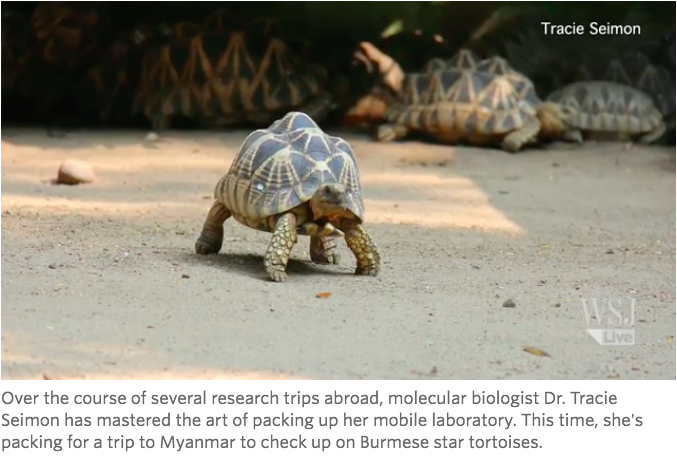How a Molecular Biologist Prepares for Fieldwork
- THE WALL STREET JOURNAL
- Aug 20, 2014
- 3 min read
WHAT'S IN YOUR BAG?

By HILARY POTKEWITZ
Some people light incense in the shower to set a mood. Tracie Seimon uses it for protection: The smoke keeps the swarming mosquitoes at bay during the most vulnerable 15 minutes of her day.
As a molecular scientist with the Wildlife Conservation Society based at New York's Bronx Zoo, Dr. Seimon travels several times a year to tropical locations to test animals for diseases that could threaten a species.
In mid-September, she will be bringing her team to Bagan, Myanmar to examine a group of endangered Burmese star tortoises hatched in a breeding program. Each tortoise needs a clean bill of health before being released into the wild. In May, Dr. Seimon was in Uganda studying a fungus threatening world-wide frog populations.
When it comes to bug repellent, she insists on a DEET concentration of at least 30%. She dismisses any popular concerns about its toxicity. "I'm more worried about getting a tropical disease than I am about the long-term effects of DEET," Dr. Seimon says. (Malaria, yellow fever, dengue fever, West Nile virus and encephalitis are all mosquito-borne illnesses, according to the U.S. Centers for Disease Control and Prevention.)
Growing up in Colorado Springs, Colo., Dr. Seimon always knew she wanted to be a scientist working with animals. When her parents gave her a microscope at age 10, she spent days collecting pond scum. By high school, she was breeding aquarium fish out of five tanks in her bedroom.
She has been with the WCS since 2010, traveling with a mobile laboratory to do DNA testing of viruses and bacteria in animal cells. Her equipment includes a mini-centrifuge, a fluorometer, which measures how much DNA was recovered, a mini-freezer, and a supply of plastic tubes and rubber gloves, which all get packed into 24-gallon Rubbermaid ActionPacker cargo boxes.
For personal items, it's carry-on only. Dr. Seimon brings two long-sleeved safari-style shirts, a pair of Columbia travel pants made of mosquito-repellent fabric, a T-shirt and powdered laundry detergent.
Her trips usually involve nights in the field, so she brings her own bed mosquito net by Texsport. A mini-medical kit is essential: antibiotics, probiotics for stomach woes, Advil and Emergen-C, a powdered vitamin-supplement drink. Her sparse toiletry kit holds little bottles of liquid soap, shampoo and Neutrogena sunscreen.
Dr. Seimon brings a wrap or sarong that does double duty as a coverup for outdoor bathing and, when tied at the waist and topped with a blouse, completes an outfit appropriate for dinner with local government officials.
Because the electricity can go out any time, she carries a Black Diamond headlamp, even to dinner.
Dr. Seimon takes along an iPhone, MacBook Pro and a Canon 60D camera. Her hobby is macrophotography, which involves taking extreme up-close photos, and she uses a Canon EF 100 mm macro lens to zoom in on nature. She keeps a travel log in an all-weather memo book by Rite in the Rain.
Her most-treasured item? It's a tossup between her WCS staff baseball cap, which she's wanted to wear since she was a child, and her emergency Starbucks kit.
"I'm kind of a coffee snob," Dr. Seimon says, holding a plastic bag full of Starbucks VIA instant coffee packets and small bottles of sugar and powdered milk. "I don't go anywhere without this."










Comments